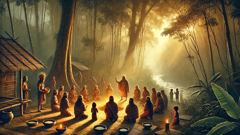Introduction
On the damp, fragrant mornings when the jungle breathes slowly and the mist lifts like a curtain from a hidden stage, the Temuan speak of voices that are older than the tallest trees. These are not idle tales but living threads—legends that fold into the daily arc of hunting, planting, healing, and remembering. The Temuan, one group among Malaysia’s diverse Orang Asli communities, keep a folklore that feels less like a museum of old stories and more like an atlas for surviving and belonging to the forest. Their songs and warnings, their etiquettes for stepping through undergrowth and across river-stones, are small moral maps that mark borders between what the world demands and what the spirits ask. This introduction invites you to stand at the edge of that map and to walk inward with quiet respect. The forest in Temuan lore is at once home and teacher: trees have names, streams have moods, and certain clearings hold the footprints of beings who are neither wholly human nor wholly spirit. Temuan myths explain why certain paths are avoided at dusk, why particular leaves are offered when a hunting trip is long, and how a child born on a stormy night might be known to the community as one who can hear more than others. These tales tie the rhythms of community life to a cosmology where balance is maintained by remembrance, ritual, and sometimes gentle fear. In the pages that follow, you will meet origin figures who shape identity, spirits who guard or mislead, and the keepers—the elders and shamans—who translate whispers from the canopy into practical rules for living. You will read of rites that stitch the present to origins and of songs whose melodies act as both lullaby and legislation. Most of all, you will discover that for the Temuan, the forest is not empty wilderness; it is a crowded, talkative place where gratitude and caution walk hand in hand. Respectful curiosity will guide this telling: what follows is an attempt to render with care the landscape of Temuan belief, an imaginative retelling grounded in the textures of their world—its scents, its shadow, the cadence of its speech—without claiming to possess every secret. Listen closely as we step under the canopy and speak with trees that remember.
Roots and Rites: Temuan Origins and Ancestral Tales
Temuan origin tales often begin with landscapes more than with people—ridges that breathe, rivers that remember, and a sky heavy with naming. In one telling, the first Temuan did not come into the world fully formed but were taught by a pair of guardian animals whose lives threaded between human need and forest craft. The animals taught which plants cure which wounds, which birds signal rain, and how the community must behave when the moon hangs low and predators roam. In another story, an ancestor walked out from a cave that had a roof of roots and light, holding in his hands a handful of fire embers and seeds; he distributed both with equal reverence, because the Temuan recognize that heat and life must be nurtured together. The moral logic in these tales is not abstract: roots become rules. If a family fails to honor a particular clearing or forgets to sing for a certain spirit, the leaves will close and provide less fruit, or a river will move its fish to a quieter bend. That reciprocity—give to keep—is an ethic embedded within origin itself.

Elders, the human libraries of the Temuan, often open their teachings in lists of obligations. There are lists of days when one must not hunt, lists of trees that are never felled for sure reasons, and small ceremonies to be observed before crossing certain wooden bridges. The rites are neither elaborate nor grandiose; they are precise and intimate. The rite before a long hunting journey may require the hunter to stretch a woven cord under his belt, chew a small leaf that children also use as a toy to keep fear at bay, and speak a name—the name of the forest that will keep him close to its true paths. Naming is powerful in Temuan belief. To speak the precise name of a river, a tree, or a spirit is to recognize it; refusing that recognition risks disrespect. Among the Temuan, names are offered, not seized.
The role of the shaman—often referred to in Temuan speech by terms that translate awkwardly into English as healer, seer, and mediator—bridges the practical and the cosmological. Shamans are custodians of ritual sequences as much as they are doctors of bone and fever. They are called not only to cure but to counsel: when a crop fails, their work is as much about re-establishing respect with the soil’s unseen inhabitants as it is about replanting rice. Their songs are filled with catalogues of names that stitch the present moment to the first planting. A small sample of an elder’s chant reads like a ledger: the name of the stream remembered, the name of the tree thanked, the founder ancestor invoked, the name of the spirit who dislikes haste. The chants have rhythm and repetition for memory, but they also teach behavior: go quietly, do not take more than you need, always leave a gift.
Rituals also mark transitions—birth, first hunt, marriage, and death—each with their own patterns. Birth is often celebrated not only because another life has joined the village but because the community now has a new listener for the forest’s stories. Some children are thought to have particular affinity with certain spirits; these glimpses of potential determine training in song, plant knowledge, or the arts of weaving and canoe-building. The first hunt for a young hunter is attended by elders who observe what the child says or does at a riverbank; an uttered phrase or an instinctive respect can signal a stronger harmony with the land. Marriage rites honor both families’ relationships with places—the couple is asked to promise to remember which trees belong to which kin, and to uphold those boundaries. Death is treated with layered mourning and a kind of mapping: the dead are credited with having crossed particular thresholds, and rituals ensure their names continue to be spoken—not to summon, but to keep the account of obligations complete.
Temuan origin stories weave cosmology into daily practice so tightly that children learn both by play. Games often rehearse the right way to approach a sleeping animal or the correct posture for leaving an offering. The lessons are transmitted without didacticism: through story, song, and the soft sanctions of community disgrace when rules are flouted. Sanctions are rarely violent; reputational memory and the risk of spiritual misfortune are a powerful deterrent. When someone disrespects a known sacred tree or uses a charm in secret for greed, elders might respond with a story told again at dusk: a parable of someone who took and became small, who forgot names and was lost. The point is not to punish but to teach the consequences of forgetting.
Language itself is a vector for cultural continuity. The Temuan dialect contains specific vocabulary for ecological relations that resist tidy translation. Terms exist for the sound of particular insects at dusk, for the way water moves around a submerged root, and for a planter’s correct posture when sowing. These words encode local knowledge: where to find a medicinal vine, how to read the patterns of cloud and humidity, how to choose a canoe’s seam. When outsiders learn Temuan vocabulary, they often find that the words demand learning of the world they describe; a language that preserves a practice quietly insists that the practice continue. Thus, oral storytelling is not a mere pastime but an instrument for survival.
The act of telling, then, is itself a ritual. Each story retold is an offering and a contract. The community gathers around modest flames; elders modulate their voices according to the story’s needs—low and breathy for cautionary spirits, bright and rhythmic for celebration. Younger listeners learn to lean in or to laugh in the places that welcome mirth. The most sacred narratives, those that speak of the first pacts between humans and the world, are told slowly and only on certain nights. Outsiders who ask to hear these stories are often offered a more public version—full of wonder and legend, but stripped of ritual specifics that belong to the clan. Respectful curiosity is rewarded; prying is not.
These ceremonies and origin tales continue to shape Temuan identity in a rapidly changing world where roads and development stretch into previously hermetic spaces. Elders adapt: they explain to children that some spirits are resilient, others retreating, and new rhythms of life require new songs. Yet the core teaching remains: names matter, balance matters, and living in the forest always requires a listening heart. This belief is both poetic and pragmatic; it helps the Temuan navigate the dilemmas of modernity while anchoring them in a lineage that insists on remembering how to stand within the world rather than merely upon it.
Spirits of the Canopy: Encounters, Cautionary Tales, and Living Traditions
Among the most compelling facets of Temuan folklore are the multiplicity of spirits that inhabit the canopy and the floor of the forest—beings who are sometimes helpful, sometimes mischievous, and sometimes inscrutably indifferent. The Temuan vocabulary for these presences resists Western binaries of good and evil; instead, spirits are defined by relation. A spirit who is respected and fed will protect, while a spirit who is neglected—or who has been slighted by the thoughtless cutting of a tree—may respond with mischief or withdrawal. A particular class of spirit often appears in local stories as the caretakers of hidden orchards: not human growers but beings that shield particular fruit trees and claim the right of first harvest. Hunters who ignore the quiet rules—such as leaving a small portion of meat or touching a designated offering stone—may find their snares empty or their dogs led astray. These stories function as ecological governance: a narrative that enforces restraint becomes a way of protecting a resource.

Cautionary tales are common and carefully attuned to context. There is a story often told in ways that vary from village to village about a man who entered the forest at the hour when night and dawn were indistinguishable. He pushed aside a low root in search of honey, disregarding the soft pile of offerings that others had left. He took, and later he found that the honey returned to its hollow while his hands were sticky with a cold that would not leave. He developed a stubborn cough that no local healer could quiet until he returned the exact portion of honey and named aloud the tree and the spirit that had been wronged. The moral lesson is twofold: first, do not take what is consecrated; second, remedy requires not only physical restitution but also the recognition of a wrong in words and ritual.
Some spirits teach directly, offering knowledge to those who listen. These are often the spirits associated with mountain summits or deep pools—places where a listener might go alone to seek remedy or counsel. A Temuan tale recounts a young woman who, troubled by visions that made her family uneasy, spent nights at the edge of a sacred pool. There she encountered a shadow who asked only that she call it by its full name and promise to thank it in the morning. The woman did so, and the shadow taught her a series of plants that quieted the visions. When she returned, she taught the clan the remedies she learned. Stories like this position spirits as both gatekeepers and teachers. They are not always benevolent in the way Western folk stories imagine fairy godmothers; their help is conditional and costly in that it demands proper acknowledgement.
There is also a class of narratives about the trickster—spirits who relish confusion and reversal. In some versions these beings are small and quick; in others they are indistinct, more like mischief in the air. They may rearrange tools left unattended or mimic the calls of animals to lead a hunter astray. The trickster’s function is pedagogical: to instill humility and attentiveness. A child who learns to laugh at harmless pranks grows into an adult who can keep perspective when true danger arises. But the trickster can also escalate; persistent disrespect can coax it into cruelty by human standards. Thus, the tale of the trickster functions as a warning about the slow erosion that comes from thinking oneself superior to the forest’s intelligence.
As conditions change—roads intrude, new crops are planted, and youth migrate to towns—Temuan folklore adapts. Older stories are reframed as metaphors for social problems: a spirit that withdraws its favor may be used to explain diminishing fish returns to a river newly constrained by dams, while a tale about a family who hoarded food becomes a parable about unequal access or greed. Elders tell these updated stories in ways that keep the core message: responsibility to the land must be matched by responsibility to one another. In some communities, ritual has become a way to reclaim land that development projects have threatened. Public ceremonies that were once private are brought into larger gatherings as a form of assertion: to show that these lands are lived and named and not simply vacant.
There are also living traditions—songs, weaving patterns, and culinary practices—that function as mnemonic devices for conservation and identity. A particular motif woven into a mat can encode the memory of a river’s bends; a lullaby’s cadence can mirror the timing of a planting calendar. Cooking practices preserve knowledge of what to eat during certain seasons to avoid overharvest of delicate species. These are modest acts of stewardship built into everyday life. And when younger Temuan return from cities to marry or to care for aging parents, they bring back new tools and different perspectives. Young people may blend that knowledge into hybrid practices: using a modern container to keep an offering intact, or translating a ritual blessing into Malay for an urban audience while retaining the original refrain in Temuan speech.
Encounters with outsiders layer further complexity onto the folklore. Missionaries, anthropologists, and developers have all sought narratives: some to study, others to own. The Temuan respond variously—some elders welcome exchange and use storytelling to teach outsiders about respect for land; others retreat, wary of commodification. A common stance among storytellers is to share public tales freely while safeguarding rites that regulate ritual potency. This careful curation of narrative speaks to a people who have long navigated contact with other cultures while maintaining a core cosmological literacy.
Practical wisdom often underlies seemingly supernatural tales. For instance, a story of spirits who take those who wander alone after dusk may have served as a protective device to prevent people from moving through unfamiliar territory at dangerous hours. A story of a lonesome ghost near a river that calls in soft voice could be a metaphorical caution against the treachery of slick river-stones and hidden currents. Yet the Temuan allow for both literal and metaphorical readings. The multiplicity of meanings enriches life: a person might believe deeply in the spirit and also accept the pragmatic caution the story conveys.
Finally, the resilience of Temuan folklore lies in its capacity for generative renewal. New stories arise that speak to contemporary fears: a tale of a spirit wounded by plastic waste, for instance, sternly rebukes a world that discards without thinking. The moral core of the folklore—reciprocity with the land, ritual humility, and communal memory—remains constant even as the narrative surface shifts. The forest keeps speaking, and the Temuan keep answering in song and ceremony, in ritual and in the daily small ways that stories shape how they walk on the earth.
Conclusion
Temuan folklore gifts us an image of the world as intimate, named, and interdependent: trees are not scenery but interlocutors, rivers are not conveniences but relatives, and spirits are not mere figures of fear but partners in a co-authored life. Reading these stories with care, we see that they are both pedagogy and poetry. They instruct communities on how to sustain the resources they rely on and they provide the narratives that make community possible. The Temuan teach that memory preserves resources as much as law does, that stories keep names alive and names keep obligations current. As development and modern pressures press outward from cities into the jungle, these tales gain new urgency: they are not relics to be archived but active protocols for living in balance. To listen respectfully to Temuan legend is to learn an ethic of reciprocity that can inform anyone who walks under the same sky. These stories invite us to slow our pace, to honor the small offerings that bind communities to place, and to remember that in many parts of the world, the land does not remain neutral in the face of human desire; it replies with stories, with retribution, and with gifts, depending on how we choose to answer. If we choose to listen, we may find that old names are not nostalgic relics but necessary guides, and that the wisdom to live well in the forest is still, quietly, singing.













